The heterobarrier structure consists of n-InGaAs, undoped-InP, and n-InP layers. As the Fermi level in highly doped n-InGaAs can be located far above the conduction band edge depending on the carrier density, the barrier height at the hetero-interface (ΦBn) can be lowered to 100meV or less. Due to the low barrier-height, the FMB diode results in a good NEP of about 5.0pW/Hz0.5.
UTC-Photomixer module
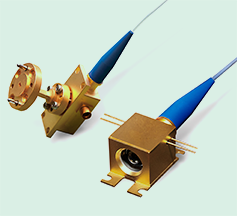
Photonic generation of THz signals is promising for various applications. The uni-travelling-carrier (UTC) photomixer is one of the best solutions, because it provides a high 3 dB down bandwidth and high-saturation-output power simultaneously.
NTT Innovative Devices have developed two types of UTC photomixer modules. One is a compact rectangular-waveguide-coupled photomixer, and another is an antenna-integrated photomixer module.
FEATURES
- Efficient CW THz generation
- Rectangular waveguide coupled photomixer
75 to 380 GHz with 4 types of W-, F-, D-, J-band photomixer - Antenna-integrated photomixer (quasi-photonic type)
250 to 3000 GHz or higher
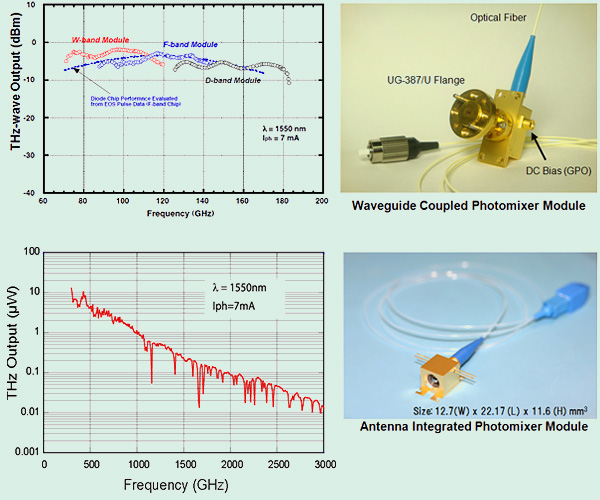
SPECIFICATIONS
| Type* | Model | Frequency | Output Power | |||||
|---|---|---|---|---|---|---|---|---|
| Min | Center | Max | Unit | Min | Typ | Unit | ||
| W | IOD-PMW-13001 | 75 | 90 | 110 | GHz | -8.0 | -5.0 | dBm |
| IOD-PMF-13001 | 90 | 115 | 140 | GHz | -8.0 | -5.0 | dBm | |
| IOD-PMD-14001 | 110 | 140 | 170 | GHz | -9.0 | -6.0 | dBm | |
| IOD-PMJ-13001 | 280 | 330 | 380 | GHz | -18.0 | -11.0 | dBm | |
| A | IOD-PMAN-13001 | 300 | - | 2500 | GHz | -34.0 | -28.0 | dBm |
*) W-type is a waveguide coupled type photomixer. Output power is measured at the centre frequency.
A-type is an antenna-integrated photomixer. Output power is defined as the maximum power.
FMB diode module

Femi-level managed barrier (FMB) diode module is an ultra-low noise THz detector based on InP/InGaAs heterostructure. Instead of metal/semiconductor interface in a Schottky barrier diode (SBD), InGaAs/InP hetero-interface (barrier height ~ 100meV) is used in an FMB diode.
This low barrier height provides a low diode differential resistance (Rd) and good impedance matching between a diode and a broadband bowtie antenna.
FEATURES
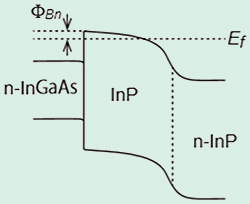
FMB diode with OP Amp.
 IOD-FMB-18001
IOD-FMB-18001
The IOD-FMB-18001 module is ideal for applying square-law detection with ultra low noise. The voltage sensitivity obtained was as high as 2MV/W at 300GHz, and 0.2MV/W at1THz.
The noise equivalent powers (NEPs) were estimated to be as low as 5.0pW/Hz0.5 at 300GHz, and 45pW/Hz0.5 at 1THz.
FMB diode with TIA
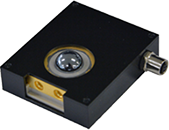 IOD-FMB-19001
IOD-FMB-19001
The IOD-FMB-19001 is the quasi-optical FMB diode module with a broadband transimpedance amplifier (TIA). The module exhibited a differential voltage sensitivity of about 17kV/W at 300GHz in the square-law detection mode and an IF bandwidth of about 11GHz in the heterodyne detection mode. For 300GHz operation, the lowest NEP obtained was about 1.1x10-18W/Hz with an LO power of only about 6μW.
SPECIFICATIONS
| Item | Spec | |
|---|---|---|
| Model | IOD-FMB-18001 | IOD-FMB-19001 |
| Module configuration | Zero-bias FMB diode with op-amp | Zero-bias FMB diode with TIA |
| Antenna type | Self-complimentary bow-tie antenna | Self-complimentary bow-tie antenna |
| Lens type and diameter | Hyper-hemispherical (10mm dia.) | Hyper-hemispherical (10mm dia.) |
| Terahertz bandwidth | > 200GHz | > 200GHz |
| Pre amplifier type | Low-noise operational amplifier | Transimpeadance amplifier |
| Pre amplifier bandwidth | 20Hz - 15kHz | 30kHz - 11.8GHz |
| Output connector | SMA (Female) | SMPx2 (male, differential output) |
| Noise equivalent power (NEP) |
5pW/sqrt(Hz) @300GHz 45pW/sqrt(Hz) @1000GHz |
15pW/sqrt(Hz) @300GHz |
| Voltage sensitivity | 2MV/W @300GHz 0.2MV/W@1000GHz |
17kV/W @300GHz |
| Electrical power supply | DC±5V | DC+3.3V |
DIMENSIONS
IOD-FMB-18001
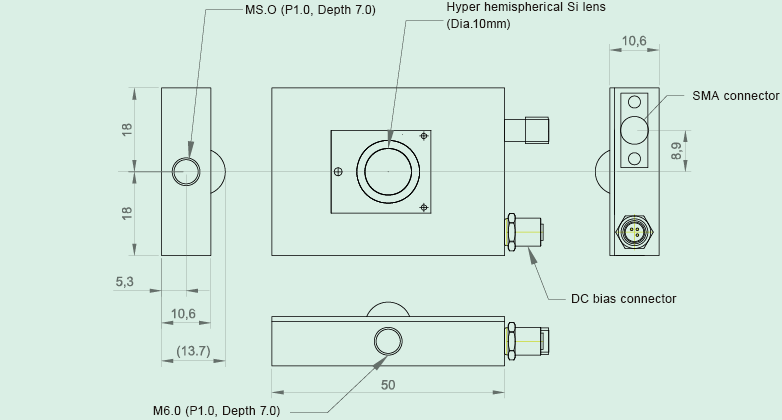
IOD-FMB-19001

100 GHz Baseband Amplifier (IOD-AMP-100)
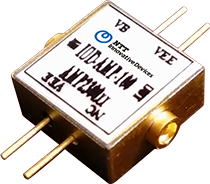
This ultra-compact baseband amplifier with DC blocks provides a flat gain of 8 dB in a frequency range of 300 kHz to 100 GHz. An InP-based heterojunction bipolar transistor (InP HBT) IC technology is applied to realize this ultra broadband performance.
The integrated DC blocks in input / output ports allow direct connections of various electrical interfaces. It uses push-on type coaxial connectors (G3PO compatible) and an ultra-small metal package with a volume of 0.5 cc. The amplifier is suitable to boost the amplitude of digital signals with a speed of up to 150 Gbps.
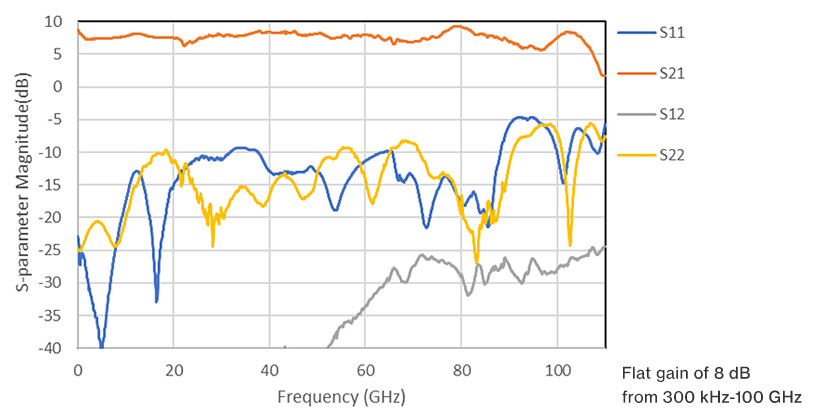
- Flat gain of 8 dB (300 kHz-100 GHz)
- Built-in DC block
- Ultra-small package (0.5 cc.) with push-on type coaxial connectors (G3PO compatible)
J-band Power Amplifier (IOD-PA-J)
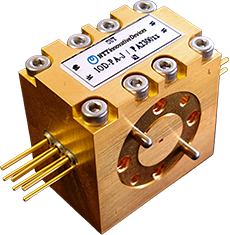
This power amplifier provides a power gain of 10 dB in the J-band frequency range (220-320 GHz) and a saturated output power of 8 dBm.
An InP-based heterojunction bipolar transistor (InP HBT) IC technology is applied to realize the high frequency and high output power performance. It has an easy-to-use module configuration in which the WR-03 waveguide can be connected to the input / output port. The amplifier is suitable to boost the power of J-band millimeter wave signals in transceivers for wireless communications systems or sensing systems.
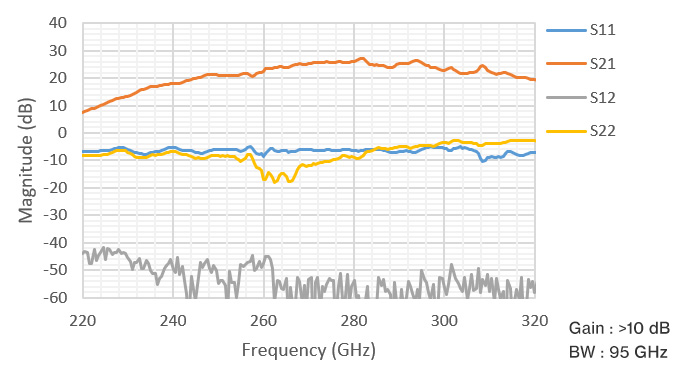
- High power gain 10 dB and saturated output power of 8 dBm in the J-band frequency range (220-320GHz)
- Ultra-small package to which with WR-03 waveguide can be connected
100 GHz AMUX (IOD-AMUX-100) / ADEMUX (IOD-ADEMUX-100)
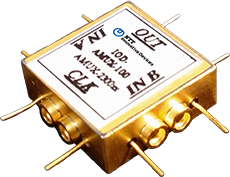
This Analog multiplexer (AMUX) and Analog demultiplexer (ADEMUX) extend a bandwidth of digital-to-analog converters (DACs) and analog-to-digital converters (ADCs) up to 100 GHz. An InP-based heterojunction bipolar transistor (InP HBT) IC technology is applied to realize the broad band performance. The module has 8 push-on connectors for input/output/clock ports.
The AMUX multiplexes analog signals from two DACs into one signal whose bandwidth is twice that of the input signals. The ADEMUX demultiplexes the high bandwidth input analog signal into two signals with half the bandwidth. They can double the bandwidth of the DAC / ADC and are expected to be used for a high-performance arbitrary waveform generator (AWG), a bit-error-tester (BERT), and other equipment for a 200 GBd class optical communication.

Bandwidth extension (up to 110 GHz)
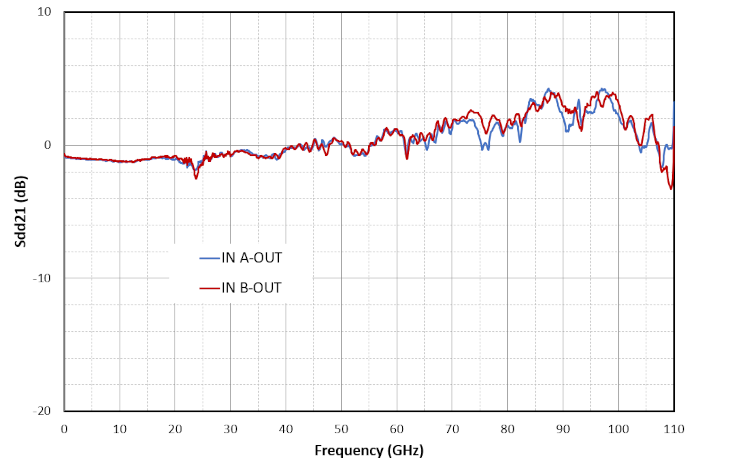
- Wideband and flat gain
- 100G-class analog bandwidth extension of D/A and A/D conversion
Specifications
| Operation Frequency (GHz) | Gain / Loss (dB) | Output power (dBm) | |||||
|---|---|---|---|---|---|---|---|
| Min. | Center | Max. | Min. | Typ. | Max. | Typ. | |
| IOD-AMP-100 | 0.03 | 55 | 110 | 6 | 8 | 10 | 10 |
| IOD-PA-J | 220 | 270 | 320 | 10 | 20 | 23 | 9 |
| IOD-AMUX-100 | DC | 50 | 100 | -1 | - | ||
| IOD-ADEMUX-100 | DC | 50 | 100 | -1 | - | ||


